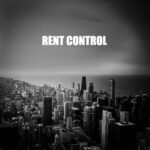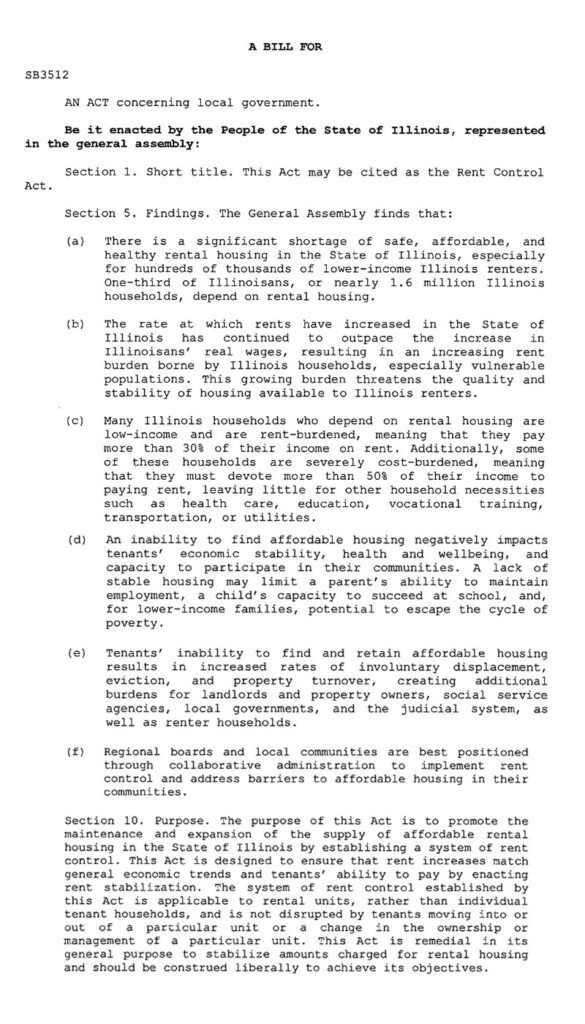 Let’s Read this Proposed Law Together
Let’s Read this Proposed Law Together
UPDATE: These provisions track with the newly introduced (Feb 9, 2019) House Bill 2192 introduced by State Representative Mary E. Flowers.
This post is the very first in a series of articles that will examine in detail the proposed text of SB3512 (Amended 5/30/18). Today, we will break down and examine sections 1 through 10 (really just three sections, so don’t worry, it’s not too much!).
Section 1 gives the law its name. The law, if passed, will be referred to as the Illinois Rent Control Act. That’s easy enough, so let’s move on.
Section 2 is a laundry list of “findings” to be made by the state legislature. This section is going to explain the policy underpinnings leading to such a (as you will soon see) slanted, one-way law as the one being proposed. In other words, the authors of the law are giving their justifications in the form of “factual findings” that will guide the development of the rent control policy and will shape the way courts will interpret the the law. This is similar in concept to the “Brandeis Brief” named after then future U.S. Supreme Court Justice Louis Brandeis who presented an argument in a 100 page brief before the Supreme Court which contained only 2 pages of legal argument and 98 pages of facts, figures, and social science testimony in support of his position. The PROBLEM with these findings, if there is one, is that many are based on a set of faulty premises and worse, even if true, the solution proposed by the law is also faulty.
So what’s contained in these so-called “findings”? If passed in the current form, the legislature will then suggest that there is a shortage of safe, affordable, and healthy housing in Illinois, especially for low income renters. Few would likely dispute this fact. Most, however, could argue for hours about the causes for this situation and could certainly dispute the various methods available to solve the problem.
The legislature suggests that rents have increased at a rate in excess of wage growth which puts a burden on renters. This is likely true as well. It is also likely true that taxes, utility fees, municipal charges, and the overall costs of running a rental business have increased in excess of the rate of wage growth. So here, the rubber meets the road. The same government that will (without ANY limit) increase taxes, fees, and charges on landlords wants to stabilize rents for tenants.
The statute then defines “rent-burdened” as people who pay more than 30% of their income on rent and cost-burdened as people who pay more than 50% of their income to rent and then suggests that such people have little money left for other purposes.
Next, we move on to some very deep political policy that landlords need to be vary careful about. The legislature makes a finding that “the inability to find affordable housing negatively impacts a tenants’ economic stability, health and well being, and capacity to participate in their communities.” You might think that this is just flowery language or a bit of puffing. It is not. It is a well considered strategy to bolster the argument that a tenant’s right to affordable housing overcomes and is superior to a landlord’s right to do with his or her property what he or she choose. If you check out the website of the Metropolitan Tenant’s Organization, you will find a statement that “We are tenants’ rights advocates educating, organizing, and empowering tenants to exercise their human right to affordable and safe housing.” Get that? They believe housing is a human right. That is the justification to impose all sorts of regulations on landlords. Will that legislature make a finding that a Landlord’s inability to raise the rent above the rent controlled amount and the obligation to make forced reserve payments for improvements to the rental property negatively impact landlords’ economic stability, health and well being? Don’t hold your breath.
They go on to make a finding that when tenants can’t find affordable housing, there is involuntary displacement and property turnover that creates additional burdens on landlords, property owners, and others. Here, they are trying to say that this law and the goals it seeks to foster will also help landlords and property owners. After you see what the law proposes, I doubt many landlords will agree.
Finally, they make a finding that “regional boards and local communities” are best positioned to address barriers to affordable housing. They, of course, haven’t cited any evidence for this, but they will argue that it is the case.
So, all of these policy underpinnings that are set forth as factual findings in Section 5 will guide and explain the law that is to come. So, what can a reader infer from the foregoing? If I were to read this set of findings as a landlord, I would not be expecting obligations that I’m a big fan of. In essence, the legislature is telling landlords “hey, whatever your problems are, they aren’t as big as the one’s faced by tenants, so that’s who we are going to benefit here.”

Finally, in Section 10, the law states its formal purpose which is to “promote the maintenance and expansion of the supply of affordable housing in the State of Illinois”. How in the world can this legislature EXPAND the supply? They tell us: by establishing a system of rent control. So, if I read that correctly, when we review that affordable housing is housing that is 30% of an individual’s income or less, they will do it by making landlords shoulder the other 10 or 20% of the rent-burden or cost-burden. You got that right. The landlords get to pay for it. Why? Well, because you own land and the tenant’s right – a human right – a health care issue – is superior to your property rights. You are NOT the king of your castle.
The law goes on to suggest that this rent control system is applicable to rental units and not individual tenant households (ie. landlords can’t avoid it) and it will not be disrupted (ie. you won’t be getting a rental rate re-set) by a tenant moving into or out of a particular unit or a change in ownership (you might sell the place, but the new owner will assume all of your burdens, thus reducing the value of your real estate). Finally, the law suggests that it is remedial in its general purpose of stabilizing rent amounts and should “be construed liberally to achieve its objectives”. That means that if a landlord finds a loophole, the legislature is telling a court that it probably has the means to close off that loophole.
So there you have it – part one of our in depth look at the proposed law. I’m a lawyer and I’m not a historian or a social scientist, but plenty of economists have written endlessly on the perils of rent control. Plenty of writers have opined on the pitfalls of taking the market out of the rental market. To say that landlords need to get involved, need to talk to their representatives, and need to get loud is a massive understatement. In the following parts of this analysis, it should become clear to landlords what they will be facing – stay tuned.

1 thought on “Breaking down the proposed Illinois Rent Control Act Part 1”
Comments are closed.